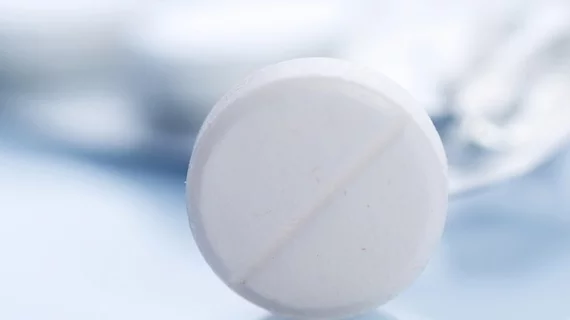DAPT with rivaroxaban improves post-ACS outcomes
The addition of rivaroxaban to aspirin monotherapy reduces the risk of atherothrombotic events in patients who have experienced an acute coronary syndrome (ACS), but it can also increase those patients’ bleeding risk, according to a study published Feb. 28 in the Journal of the American Heart Association.
Since ACS patients remain at risk for recurrent ischemic events far after their initial episode, the golden standard for treatment after an acute coronary syndrome is dual antiplatelet therapy (DAPT), which combines aspirin and a thienopyridine to minimize a patient’s risk of secondary atherothrombotic events, William J. Gibson, MD, PhD, and colleagues with the PERFUSE study group at Beth Israel Deaconess Medical Center wrote. But a year after their first event, ACS patients on DAPT are still seeing a 10 percent residual risk of CV events.
“This increased risk may, at least in part, be attributed to persistent excess thrombin generation that continues for months following an ACS,” Gibson et al. wrote in JAHA. “It is therefore plausible that the addition of an antithrombin as part of a ‘dual pathway strategy’ may reduce subsequent events, as was seen in the ATLAS ACS-TIMI studies of ACS patients.”
Gibson and his team pulled data from the ATLAS ACS-TIMI 46 and ATLAS ACS 2-TIMI 51 trials for their study, which evaluated the efficacy of a dual therapy approach using the antithrombin rivaroxaban. A total of 1,477 post-ACS patients, randomized to either 2.5 or 5 milligrams of rivaroxaban plus aspirin twice per day or aspirin alone, were analyzed for a primary efficacy endpoint of CV death, MI or stroke and a primary safety endpoint of TIMI-non-coronary artery bypass graft (CABG) major bleeding.
The researchers found patients who took aspirin plus either 2.5 milligrams or 5 milligrams of rivaroxaban twice a day saw a significant reduction in the primary endpoint compared to those only on aspirin—11.4 percent prevalence compared to 16.3 percent. Results were consistent through six months.
A 5 milligram dose of rivaroxaban was generally associated with more favorable outcomes, Gibson et al. reported, and was more effective than the 2.5 milligram dose. But the higher dose was also linked to a 1.7 percent increase in TIMI non-CABG major bleeding, while the 2.5 milligram dose wasn’t.
“It should be noted, however, that the overall number of bleeds in all three study arms was low,” the authors said. “While rivaroxaban resulted in a significant reduction in the primary efficacy endpoint, the absolute benefit may have been underestimated by the high proportion (around 50 percent) of enrolled patients with unstable angina as (their) index event. This cohort is lower-risk at baseline and may include patients misdiagnosed as having had coronary thrombosis.”
They said their results are similar to that of the recent COMPASS trial, which found the addition of rivaroxaban at a dose of 2.5 milligrams twice a day to aspirin therapy was superior to administering either agent on its own. Still, Gibson and colleagues said the present study goes further, proving the dual approach is feasible for reducing major adverse CV events in the acute phase of ACS treatment.
“The addition of rivaroxaban to a single antiplatelet agent such as aspirin may be a viable alternative to triple therapy using rivaroxaban plus dual antiplatelet therapy,” they wrote.

